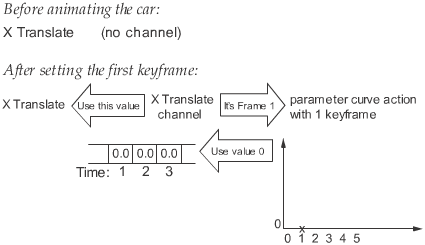Learn how a channel describes how its animation parameter can change values over time.
When an animation parameter of an item is animated, a channel is created which belongs solely to that animation parameter. The channel describes how its animation parameter changes values over time. When you view a model at different times, the channel is responsible for telling the animation parameter that it now has a different value.

To illustrate: in the car example above, at time 1 the channel tells the animation parameter it has a value of 0. At time 50, the channel tells the animation parameter to assume a value of 10.

An object is animated if at least one of its animation parameters has a channel. In Alias, a channel is created for an animation parameter by using one of the many animation tools, such as Animation > Keyframe > Set keyframe. If you later decide to remove the animation, you can use Delete > Animation > Delete Channels to remove the channel of animation.
How does the channel know which values the animation parameter should assume at different times?

In the simplest case, a channel evaluates a two-dimensional curve, which plots time against value. These two-dimensional curves are called parameter curve actions. The channel tells the action at what time to evaluate, and the action produces an evaluation value.
Actions are often created when a channel is created. What the action looks like depends on the animation tool that was used to create the channel. Using the car example, you can describe the car’s animation using Animation > Keyframe > Set keyframe. When you begin, the X Translate animation parameter has no associated channel.
Position the car at 0 units on the X-axis, and set a keyframe at time 1.

Since the X Translate animation parameter was not previously animated, a channel is created for it. The channel needs an action to tell it what values to use, and so a parameter curve action is created that has only one keyframe at time 1. Now move the car into position at 10 units on the X-axis, and set a keyframe at time 50.

Since the X Translate animation parameter is already animated, you do not have to create its channel. The channel tells the action to insert a second keyframe at time 50. The action is now a curve defined between the times 1 and 50.